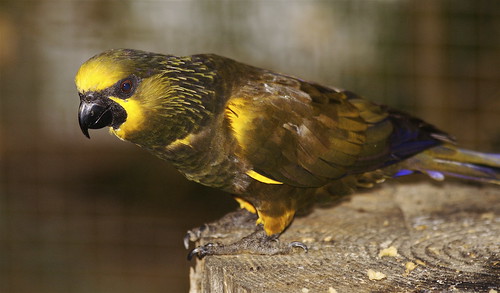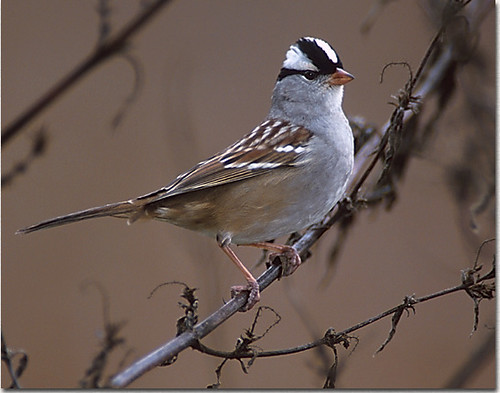A new bird in the flock
Some of you may know me already. Gunnar has been asking me to contribute to BirdingBlogs for quite some time now, but I’ve always postponed my involvement, mostly because I’ve been busy with other things and hadn’t had the time I needed to think through the specifics of what my contributions here might be.
But after a lengthy discussion in email, Gunnar once again asked me to contribute one piece each week — Wednesday would be my day — but this time, I decided that I could meet another blog commitment by sharing some of my writing about birds in science. But before I tell you about that, I thought I would start by briefly sharing a little about my background.
First, I am a birder. I’ve been interested in birds since I was six years old and caught a fledgling American robin that had flown onto my school bus. I reluctantly reunited the young bird with its frantic parents by releasing it in the front yard. After that experience, I spent a great deal of time walking quietly through fields, pretending to be a native American and listening to birds, trying to identify species. I ended up inventing my own names for many of them, names that were later displaced in my mind by the “proper” names that I discovered in field guides.
As if that American robin chick wasn’t enough to permanently steer my affections towards birds, I awoke one morning to discover an irruption of many hundreds of cedar waxwings sitting on the top of a solid wood fence outside my bedroom window. It was the first time I’d really ever seen this species. Since I was just ten years old at the time, I had no idea what an irruption was, but realised that these birds’ sudden appearance might be related to the blizzard that had deposited three-and-a-half feet of snow during the previous 36 hours. Whilst I watched them, the birds inexplicably passed a brilliant red pyracantha berry down the line of their friends perched on the top of the fence. Despite passing through all those sharp beaks, the berry remained intact, and none of the hungry birds ate it. The contrast of the golden-chestnut birds with their lemon-yellow bellies, coal-black masks and blood-red waxy wingtips against the glittering freshly fallen snow was simply magical.
Ever since that day, I’ve been convinced that there aren’t enough waxwings in the world.
Motivated by my conviction that there aren’t enough waxwings in the world, I was soon captivated by a photograph of a Duyvenbode’s lory, a honey-brown coloured parrot with a black beak and red eyes contrasting sharply with a sunny lemon-yellow face and underwings. After several years of searching, I discovered some of this species being bred in the United States. I purchased one individual and was so thoroughly charmed by her that I later started breeding birds (mostly parrots).

Brown (Duyvenbode’s) lory, Chalcopsitta duivenbodei.
This species is endemic to the island of New Guinea.
Image: John del Rio.
Even though I’ve raised many species of birds, including baby wild birds “rescued” by neighborhood kids, my primary focus is the lories (loriinae) — nectar-feeding parrots endemic to the islands of the south Pacific Ocean. Since I work with the more unusual lory species, most of my birds (or their descendants) can be found in a number of zoos in North America, with other bird breeders (aviculturists) or occasionally, with families as companion pets.
Throughout the ensuing years of working with “my” lories, I became convinced that they have a very special evolutionary story to tell, if only someone knew them well enough to tell it. I finally decided I was the person to discover and share that story, so I left cancer research and went to graduate school in zoology at the University of Washington in Seattle.

White-crowned sparrow, Zonotrichia leucophrys.
This species is common and widespread throughout the
western United States.
Image: Birds of Oklahoma.
This is where I became intimately involved with a number of bird species, especially the white-crowned sparrow, which was my dissertation bird. I studied the relationship between behavior, hormones and genetics by researching the connection between aggression, testosterone and the androgen receptor in this species. As a former cancer researcher, I also adapted molecular biology methodologies for field studies in birds. Days after I was awarded my doctorate, I relocated to New York City to pursue my “dream research project” as a postdoctoral fellow, studying the evolution and phylogeography of the lories, hoping to decipher some of the secrets that “my” birds might have.
Even as my deepening interest in birds and abiding love for science have been consistent features in my life, I’ve also been an avid writer, logophile and verbivore since I first learned to read. Originally, I hid my writing under my bed, but I’ve since become much bolder, writing several regular columns for a number of publications, and eventually striking out on my own by writing a science blog (mostly about books, birds and science) for the past seven years. Currently, I write two science blogs, Maniraptora (hosted by Nature Publishing Group) and Punctuated Equilibrium (hosted by The Guardian).
One of my longest-running blog features has been my daily mystery birds, which has been ongoing for three years and has a dedicated core following of international birders of all skill levels. If you enjoy the challenge of identifying birds from around the world based on one or two photographs, if you enjoy interacting online with people, and if you enjoy providing hints to beginning birders through the use of puns, poetry and literary references, I encourage you to visit my daily “mystery birds” feature on my Guardian blog (the mystery birds have their own homepage). The daily mystery birds is a fun collaboration between a number of photographers, scientists, writers, birders, aviculturists, zoos and interested others from around the world.
My vision for this weekly column here on BirdingBlogs is to form a communication bridge between all these different ways of being involved with birds — photographing, birding, breeding, researching. My goal is to provide birders with a glimpse into the world of science and to share some of the knowledge that scientists gain from studying birds. I hope to do that by exploring the complex relationships between people and birds, by “translating” scientific papers so you don’t have to wade through the jargon, and by getting you interested in learning more about what birds can teach us.

Welcome to Birdingblogs Deborah. It shall be very interesting to follow your posts.
Don’t know if I should be formal and call you “Ms Scientist” or more informal and address you as “Grrl,” but either way, I’m very pleased to see you writing for BirdingBlogs! I’ve admired your work for some time, and I think we will all learn from your approach.
Kenn, I thought it was Mrs Scientist now and a consequence (or maybe a cause) of the move to Germany.
What a terrific introduction and a fascinating background you have. It’s really fantastic to have you with us and really look forward to your posts!